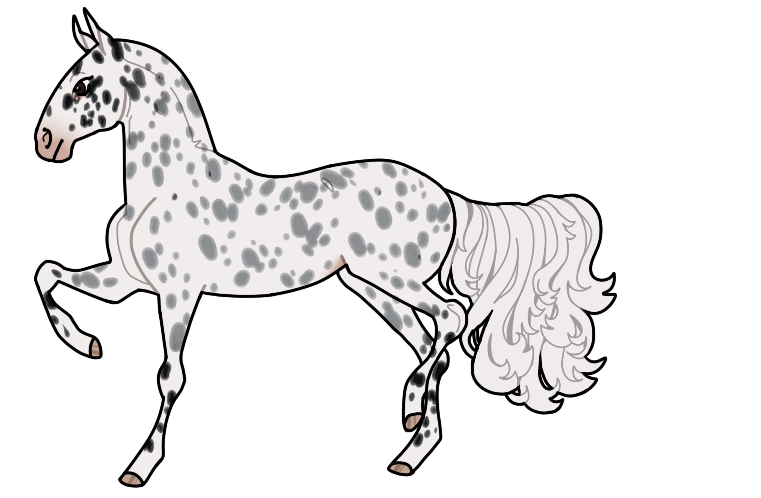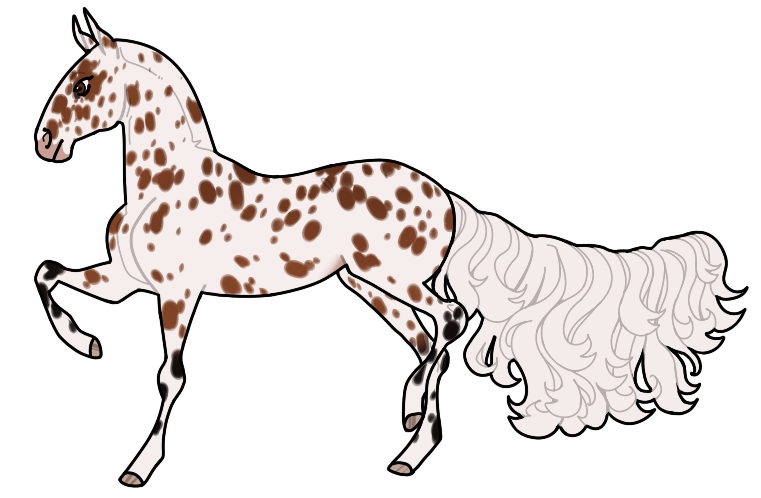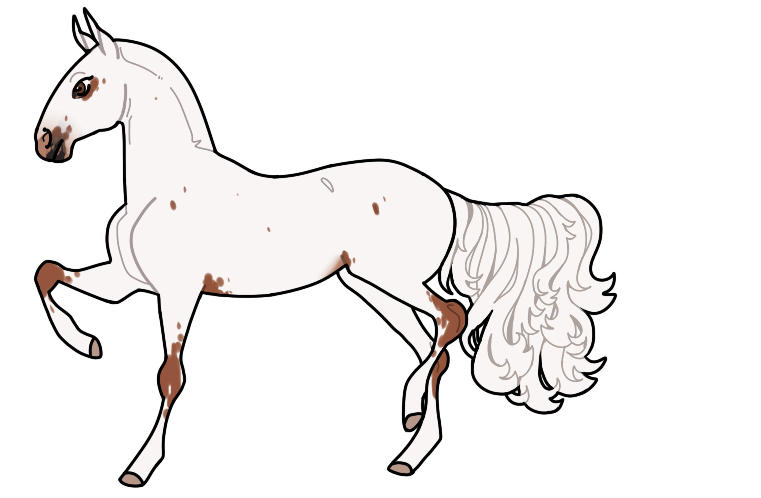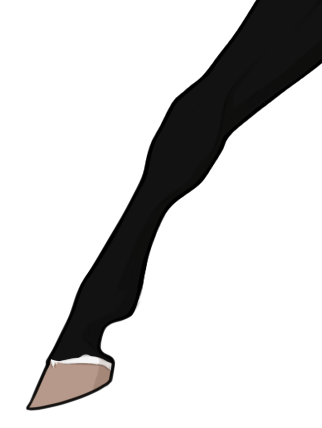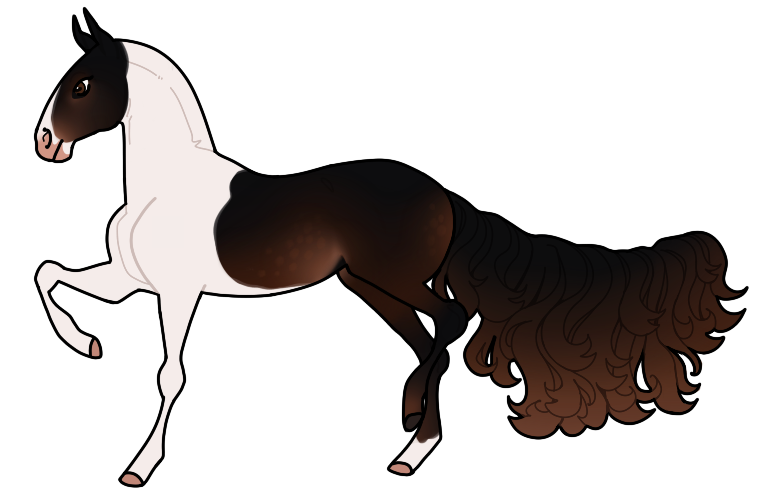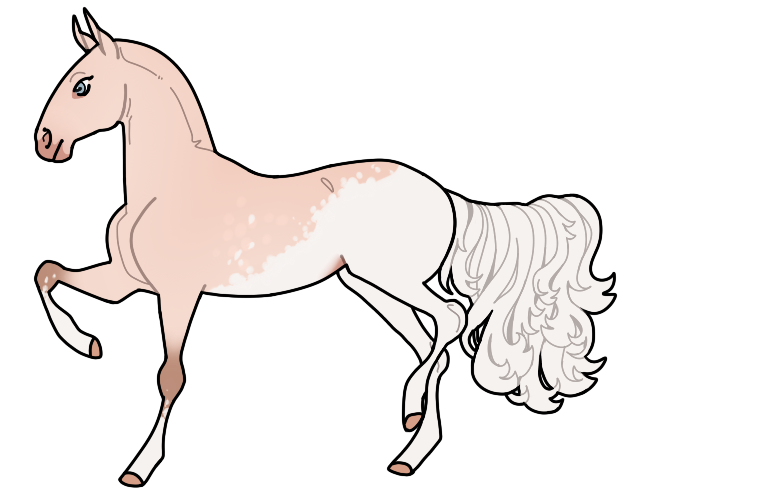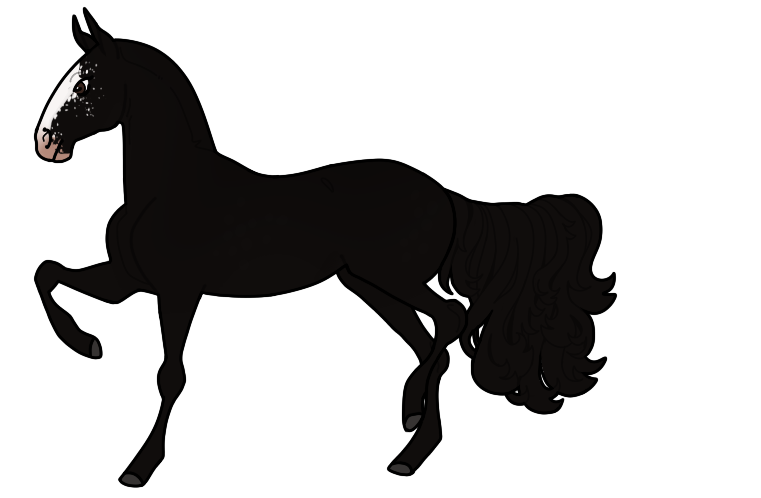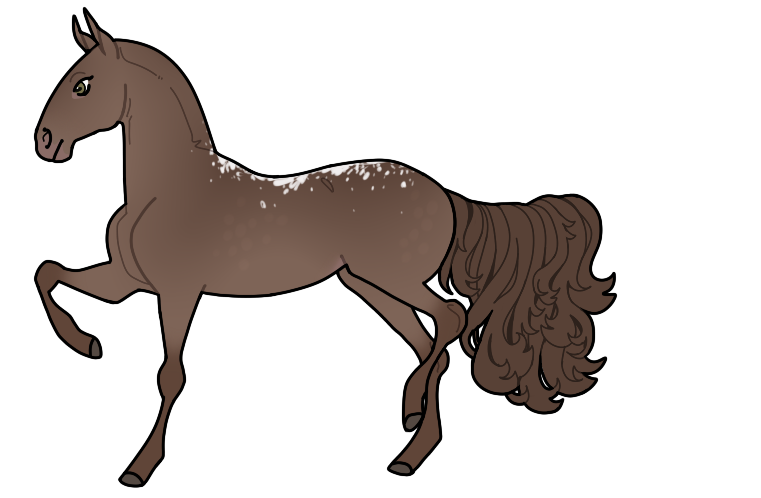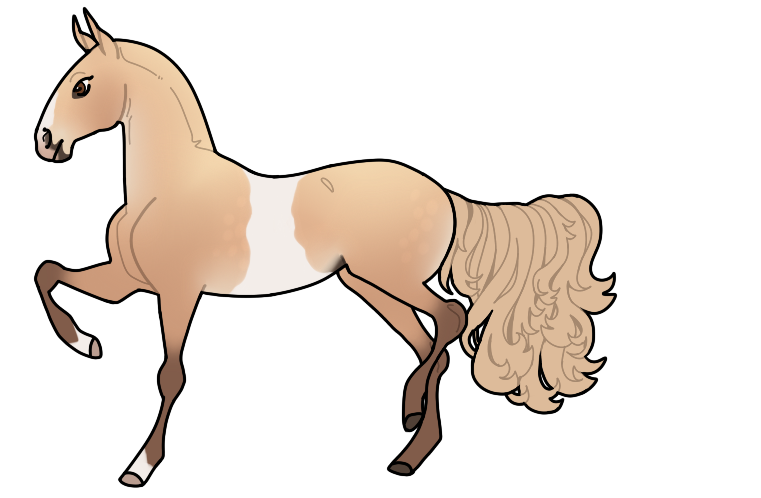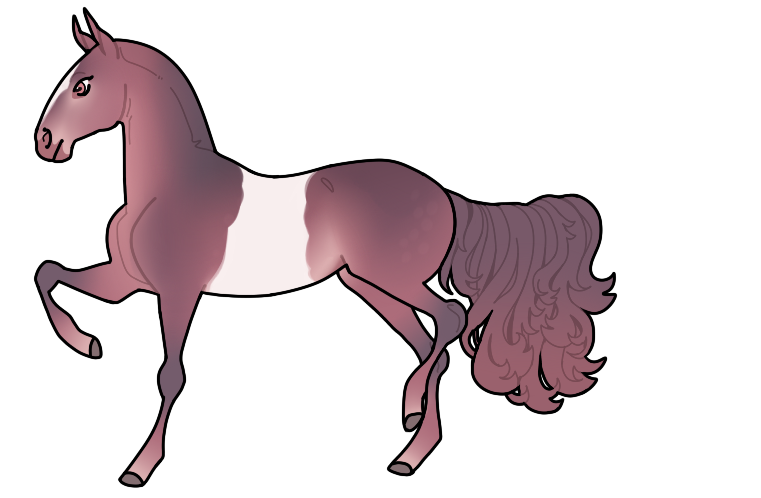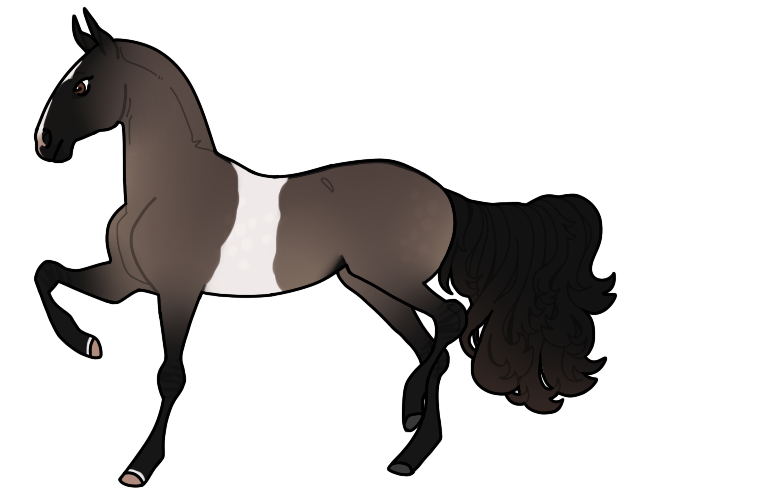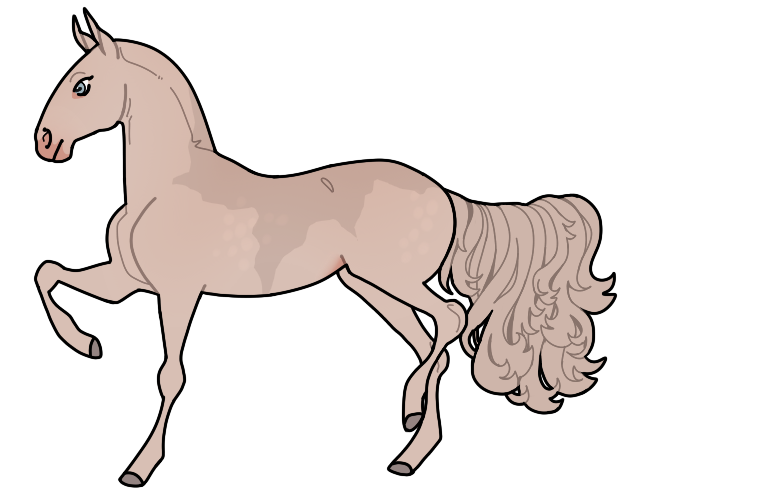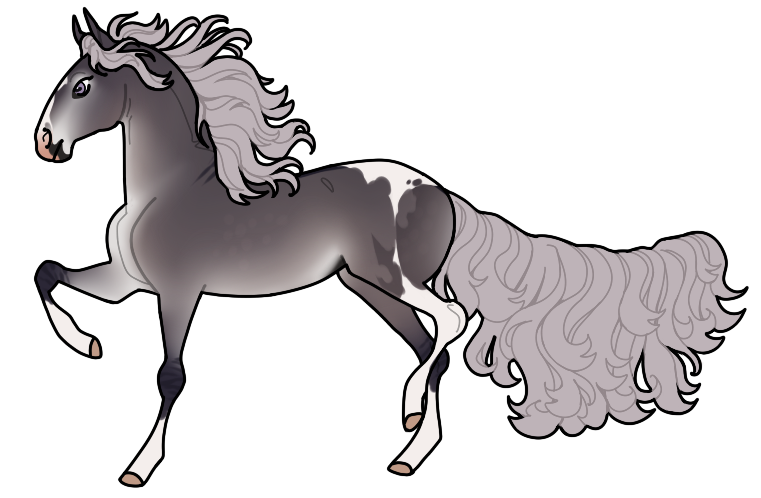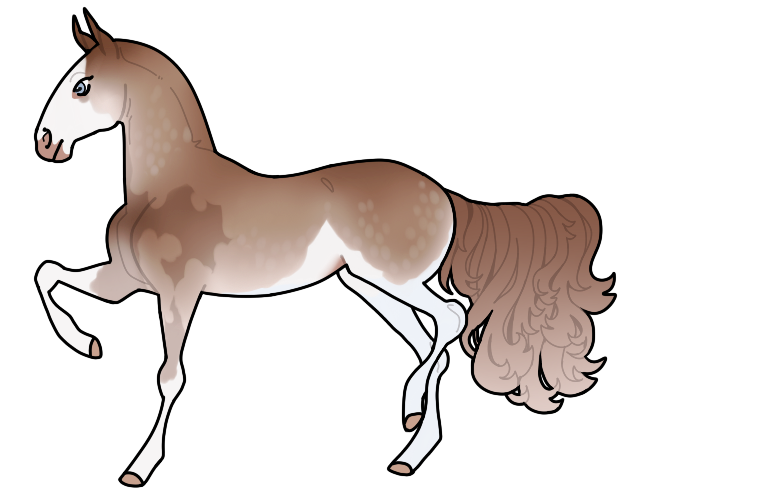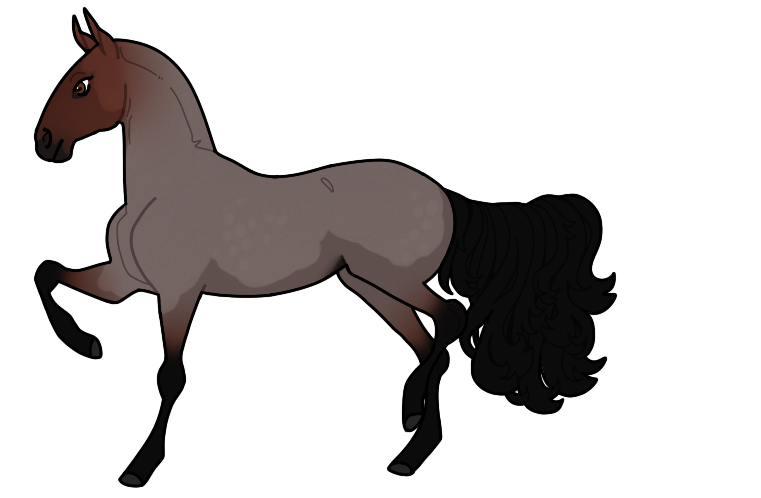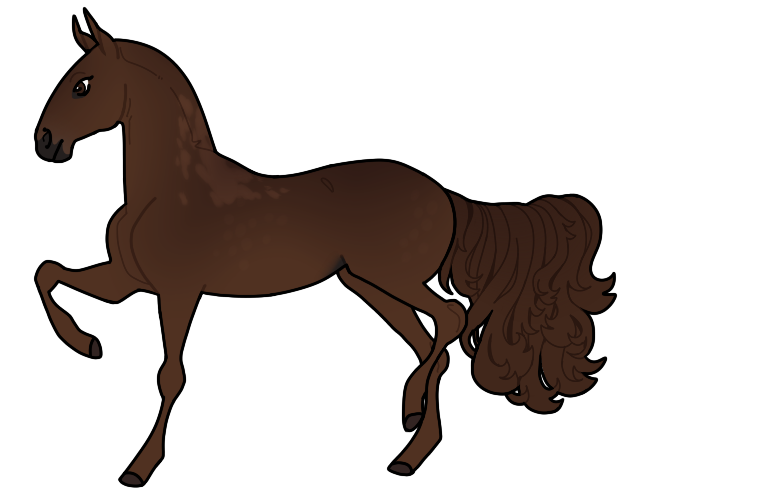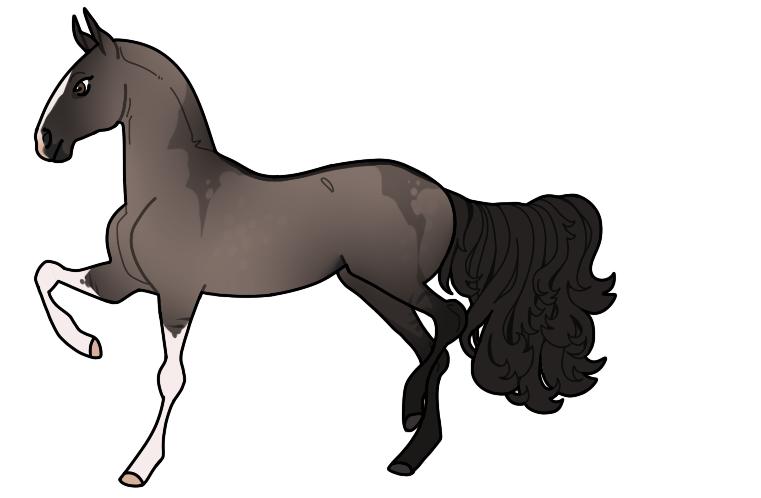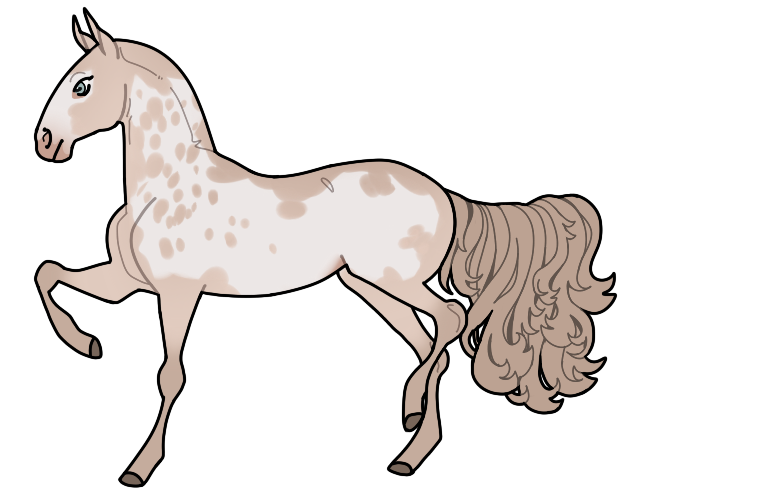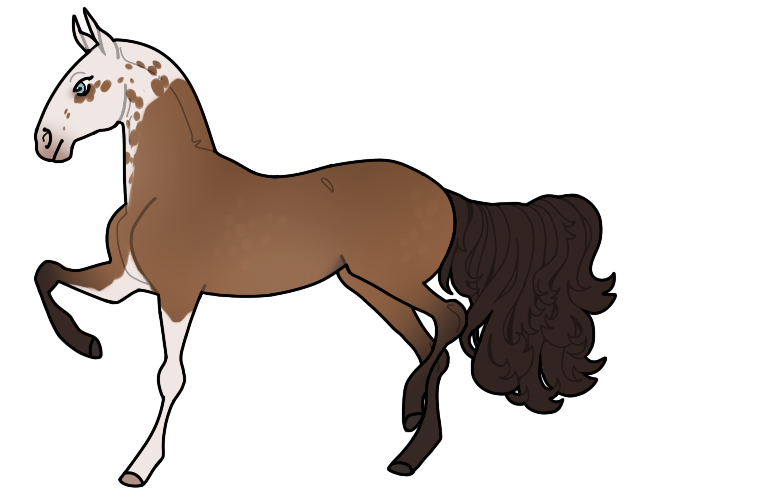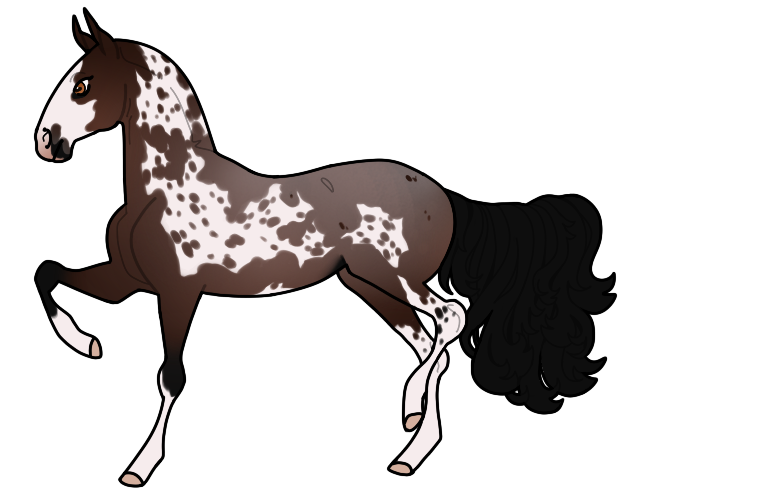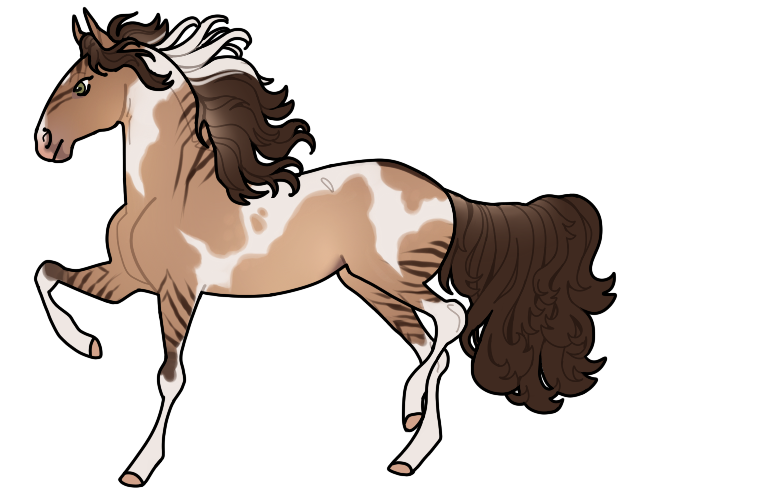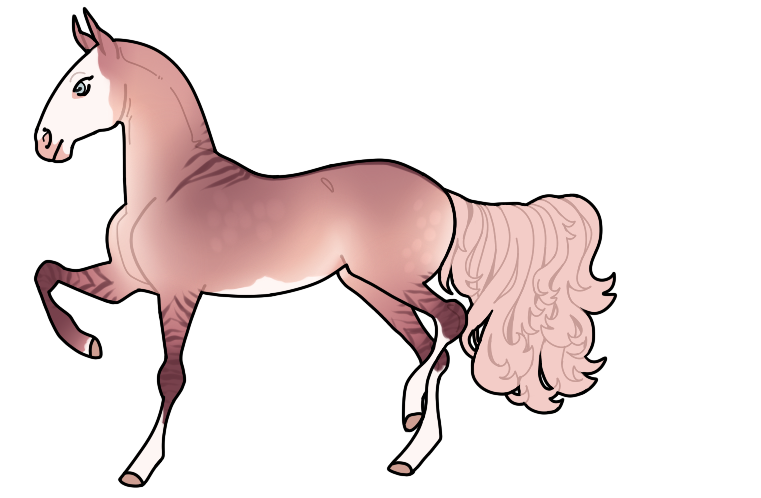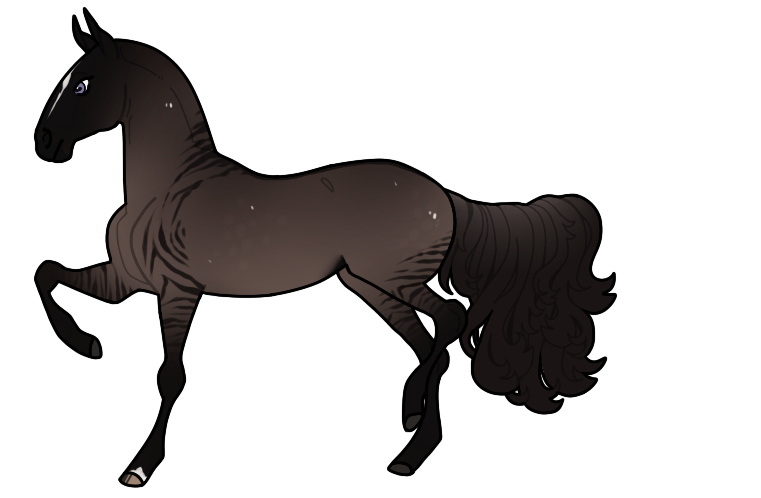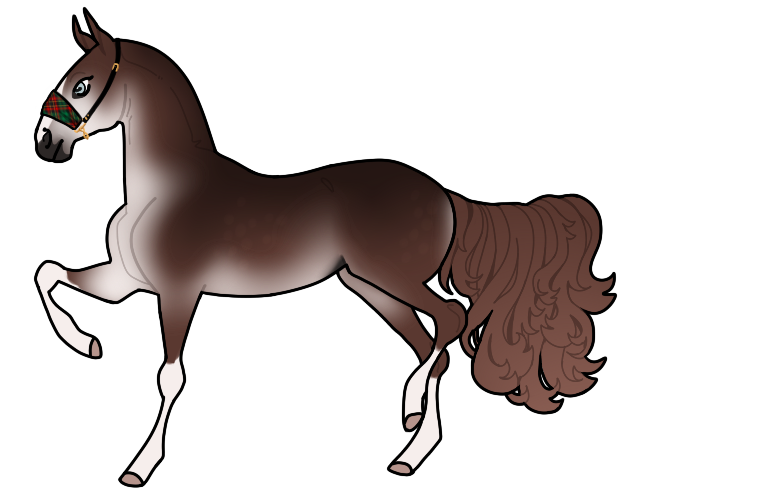Design Guide
Leopard Appaloosa (Rare)
Genetics: nLp patnpatn
Locus: Lp | Modified by patn
nLp = Snowflake Appaloosa, nLp patn = Blanket Appaloosa, nLp patnpatn = Leopard Appaloosa
LpLp patn = Snowcap Appaloosa, LpLp = Varnish Roan, LpLp patnpatn = Fewspot Appaloosa
Overview:
- Makes the coat white, with spots of the base color all over the body.
- Size of spots should generally be around eye to hoof sized, and should not be too sparse.
- Spots should generally be somewhat oblong. Can range in amount of spots, from light to very heavy.
- Spots should be present on all parts of the body, including head and legs.
- Mane/Tail: Mane will be white with streaks where spots touch. White or optionally streaked tail.
- Skin: Pink skin beneath white markings, optional pink mottling on unaffected skin.
- Hooves: Optional tan/shell striping.
- Eyes: No effect
Fewspot Appaloosa (Rare)
Genetics: LpLp patnpatn
Locus: Lp | Modified by patn
nLp = Snowflake Appaloosa, nLp patn = Blanket Appaloosa, nLp patnpatn = Leopard Appaloosa
LpLp patn = Snowcap Appaloosa, LpLp = Varnish Roan, LpLp patnpatn = Fewspot Appaloosa
Overview:
- Makes the coat white, with patches of color at the armpit/groin (required) and optionally the knee/hock, eyes, and muzzle.
- A few small spots of base color are strewn across the coat, around eye-sized or smaller. Spots should be sparse.
- Mane/Tail: White, with optional streaks (must be minimal/few).
- Skin: Pink skin beneath white markings, optional pink mottling on unaffected skin.
- Hooves: Optional tan/shell striping.
- Eyes: No effect
Natural White
Overview:
- Natural white markings may be applied to any horse, regardless of base color or additional genes.
- If a horse does not have any white pattern genes that cause extensive markings, they will be restricted within these limits.
- The image to the left shows the maximum bounds for natural white; click for fullsize.
- Face Maximum: Covers inner corner of the eye, stops at forehead, follows the line from eye corner to outer edge of nostril, wraps down chin.
- Leg Maximum: Reaches just below the knee/hock joint. May frame the bottom of the joint at most, but will not cross on to the joint itself.
Face Markings:
- Fairly smooth in appearance, and should not have overly jagged/irregular edges. Will have variance and tapering, but not excessively.
- Should be oriented vertically, not horizontally. Markings should not be wider than they are tall.
- Widest points tend to be at forehead and muzzle - markings on bridge of nose are typically thinner.
- Will not be split into more than 2-3 segments. Will not split into side-by-side pieces.
- The images below only represent a few examples and are not exhaustive!
Leg Markings:
- Must start from the hoof/coronet, filling upward. Will not originate from a different point on the leg.
- May have 1-2 small spots on the coronet band that cause striping on the hoof (must match where white covers).
- Should not be overly irregular/jagged, but may have one side reach slightly higher than the other.
- Small markings (i.e. on the heel) may hug one side, but shouldn't exceed the fetlock in height.
- Each leg is independent of the others; may be anywhere from none to max on each one.
- The images below only represent a few examples and are not exhaustive!
Rapunzel (Rare)
Genetics: rp_
* Must be homozygous to show; otherwise carried
Locus: rp
Overview:
- This mutation does not affect the coat, only the tailbone length.
- For more details, please see our Tail Tutorial page!
Snowfall (Common)
Genetics: Sf_
Locus: Sf
Overview:
- Causes speckling as if snow has collected on the topline and/or around white markings. You may choose one or both when designing!
- Topline: Concentrated on the withers/back, as if snow has been sprinkled on the horse.
- Marking: Concentrated on the border of the markings, and sprinkled slightly outward.
- Spots can vary in density and size, but should be smaller than the eye. Bigger patches are caused by dense spotting that merges.
- Spots should become sparser the further they are from the main concentration area, so that there is noticeable taper in density.
Range:
- Minimum: Must cover the withers or attach to at least one white marking - it cannot be completely hidden.
- Maximum: Snowfall along the topline and all markings. Topline concentration should only cover about 1/4 of the barrel vertically.
Corset (Common)
Genetics: Co_
Locus: Co
Overview:
- Causes a white band around the barrel.
- Should not be perfectly smooth; edges should have some degree of variance.
- Thickness can vary slightly, but should be fairly consistent from top to bottom.
- Must begin at some point on the first 1/3 of the back (measured from start of withers to point of hip).
- Cannot start further up than the start of the withers, nor end further back than the hip.
- Mane/Tail: No effect
- Skin: Pink where covering
- Eyes: No effect
Range:
- Minimum: Should be at least as wide as the withers.
- Maximum: May cover the entire barrel from withers to hip.
Stained (Common)
Genetics: St_
Locus: St
Overview:
- Stained may present in two different forms. You may freely choose either form when designing, but not both.
- Causes parts of the coat to be darkened - area/amount is dependent on the version chosen.
- Darkening should be medium/low-opacity, keeping underlying variance intact (dapples, countershading, etc).
- May exhibit darker or lighter mapping around the stained markings.
- Version A:
- Causes 1-3 random independent patches of the coat to be darker.
- Patches should have edges with cutouts, similar to the shape/edges of Overo.
- Version B:
- Darkens some or all of the white markings on the horse. Adheres to all rules/bounds for the marking, just makes them dark.
- If a marking is darkened, it must affect all white that physically touches it, even if caused by two different genes.
- Natural white may be applied on top after staining if desired (this is the only exception to the "all white that touches" rule above).
- Affects everything listed under "White Markings" on the Visual Hierarchy page.
Interactions:
- Halo: Mapping on Version B can be affected by Halo, darkening the Halo as well if the main marking is Stained.
Range:
- Minimum:
- Version A: At least one marking as large as the head.
- Version B: At least one marking affected.
- Maximum:
- Version A: Up to three different markings, not exceeding more than 1/3 of the body total on each side.
- Version B: All white markings are affected.
Version A Examples:
Version B Examples:
Blotted (Common)
Genetics: Bl_
Locus: Bl
Overview:
- Creates numerous holes in white patterns.
- Holes can vary in distribution/amount but should be somewhat oval in shape.
- Size of the holes should generally mirror Appaloosa spots, but can be a bit smaller (should not resemble fleabites).
- Can affect some or all white markings on the body, including natural white (face/leg markings).
- Affects everything listed under "White Markings" on the Visual Hierarchy page.
Range:
- Minimum: May be fully hidden.
- Maximum: May affect all white markings on the body. Must be clearly identifiable as spots/holes, not large patches.
Primitive Dun (Common)
Genetics: Dt_
Locus: B | Ty | Cv | Dt | D
CvDt = Civet, TyDt = Tabby, BDt = Bengal, DtD = Primitive Dun, nDt/DtDt = Primitive Dun
Overview:
- Dilutes the body, leaving the legs and head alone (may reach the cheek slightly).
- A modified form of Dun. Causes an exaggerated expression of primitive markings.
- Leg barring and dorsal stripe are required, while shoulder barring and facial cobwebbing are optional.
- Will extend, thicken, and overall exaggerate the stripes in these areas.
- Stripes must clearly radiate from normal dun markings, and should taper at the edges.
- Stripes on the front half of the body should be vertical, may not cross the throat/underside of the neck, and should stop just after the withers.
- Stripes on the back half of the body should be horizontal, stop at the dock of the tail (not continue on to the back), and should not pass the hip.
- Stripes on the front legs will gradually transition to become more vertical as they meet the markings coming from the topline.
- Primitive markings should be a few shades darker than the points, or black if points are already black.
- Mane/Tail: May exhibit light "frosting" blended at the roots of the hair.
- Skin: No effect
- Eyes: No effect
Interactions:
- Civet, Bengal, and Tabby: When paired with these genes, Primitive Dun will be hidden and have no effect.
- On renamed Dun combos, "Primitive" will be written before the color rather than after (Primitive Grullo, Primitive Red Dun, Primitive Dunalino, etc).
Range:
- Minimum: Dilution (lightening) of the body, as well as leg barring and dorsal stripe. May look like normal Dun at minimum.
- Maximum: Extension of all primitive markings (leg barring, shoulder barring, facial cobwebbing) to the bounds described above.
Bengal (Uncommon)
Genetics: B_
Locus: B | Ty | Cv | Dt | D
BCv = Bengal, BTy = Bengal, BD = Dun Bengal, BDt = Bengal, nB/BB = Bengal
Overview:
- Vertical stripes should cover the entirety of the neck and body, becoming horizontal on the legs and stopping at the knee/hock.
- Stripes should always be darker than whatever is below them, either in one solid color that is darker than all other points or darkened to follow the body gradients.
- Stripes should vary in thickness, have tapered ends, and should not be perfectly straight nor overly wavy. They should follow the flow/curves of the body, striping vertically from topline to underside. Stripes may merge but not cross.
- If present on the face (optional), stripes should be smaller and focused around the eye/forehead/cheek area rather than the entire head. Head markings should look fairly cat-like (similar to tiger or tabby face markings), rather than radiating out like Dun cobwebbing.
- May optionally cause subtle/medium lightening beneath the stripes on the underside, inner legs, muzzle, and cheeks.
- May optionally cause a white spot within the stripe pigment color on the back of the ears, similar to false eye markings on real tigers.
- Mane/Tail: Neck stripes may continue into the mane. Tail may be striped, following the direction of the hair.
- Skin: No effect
- Eyes: No effect
Interactions:
- Dun Bengal: When Dun and Bengal are present on the same horse, both will co-exist.
- Causes body dilution under the Bengal markings.
- Also causes dorsal stripe and leg barring, but not shoulder barring.
- Dorsal stripe will be underneath Bengal markings.
- Only applies to normal Dun, not Primitive Dun.
- Primitive Dun, Tabby, and Civet: Does not interact with these genes. Will display as normal Bengal, hiding the other gene.
Range:
- Minimum: Exhibits striping on the entire body, excluding the head.
- Maximum: Exhibits striping on the entire body, including the head.
Husky (Uncommon)
Genetics: Hk
Locus: Hk | P
HkP = Husky, nHk/HkHk = Husky
Overview:
- Husky is a dramatic lightening pattern that mirrors the appearance of the dog breed that shares its name.
- Lightening should be very pale and visible, sometimes near-white. It should be blended, but should generally be a little sharper than Pangare.
- Lightening must affect the face, neck/throat, chest, armpit, and belly, and may also affect the hindquarters and legs.
- Areas of lightening should follow/hug the curves of the body, coming up highest at the sides of each curved section.
- Face lightening should be a mask centering around the eye and muzzle, often filling in to connect the two and lighten the chin/cheek as well.
- May lighten the brow spot above the eyes as well, as long as the edge is still blended rather than solid.
- May also cause a softly-blended star or stripe marking down the center of the face (example).
- Leg lightening should hug the back side of the legs, leaving the most color on the knee/hock and coronets/pasterns.
- Optional darkening may be present along the topline, similar to Sooty, but this is not a requirement.
- Mane/Tail: Optional; blended lightening from the ends of the hair, up to halfway
- Skin: No effect
- Eyes: Optional; Blue | Detail Guide
Range:
- Minimum: Lightening present on the eyes, muzzle, neck/throat, chest, armpit, and groin.
- Maximum: Lightening present on the face (eyes/muzzle/brows/forehead), muzzle, neck/throat, chest, armpit, groin, legs, and hindquarters. Darkening along the topline. Light gradient from the tips of the hair.
